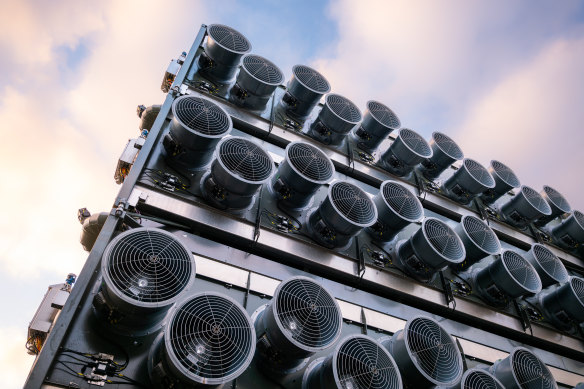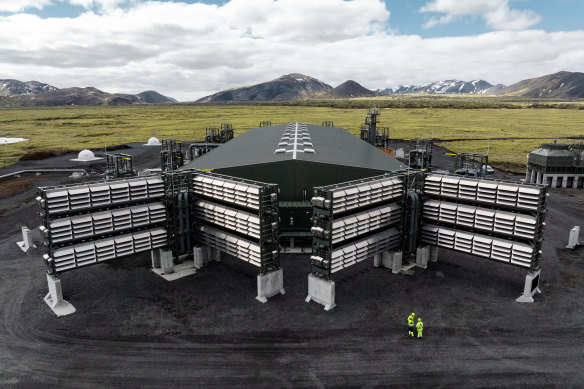Should Australia house a giant vacuum cleaner to suck carbon from the sky?
It was the second machine they built that attracted global attention. In May this year, on the flat plains of an Icelandic geothermal reserve, a gigantic vacuum cleaner designed to suck planet-warming carbon dioxide out of the sky was switched on.

Described as a carbon-sucking vacuum cleaner, the machine named Mammoth was launched in May.
The machine, called Mammoth, would not be entirely out of place on a Mad Max set. It will soon start extracting up to 36,000 tonnes of CO₂ from the atmosphere a year to be fossilised, locking it safely and permanently underground.
Mammoth is ten times larger than the previous machine made by the Swiss firm behind the project, Climeworks, but it will soon be dwarfed by newer carbon-capture machines under construction in the United States, Norway, Kenya and Oman.
Climeworks plans for expansion are staggering. As wind and solar electricity floods the market, the company plans to harness the cheap, clean energy to power its machines to suck in millions of tonnes of CO₂ per year by 2030 and reach a billion-tonne annual capacity by 2050.
Each of those tonnes might become valuable commodities in a carbon trading economy one day.
The company’s climate policy chief, Oscar Schily, is an evangelist for the cause. He is in Australia this week for a conference and to begin talks with state and federal government officials over a possible expansion here.

Set in Iceland’s geothermal fields, Mammoth uses clean energy to scrub the air.
Climate change will not be fixed by carbon removal technologies, he acknowledges. That can only be done by rapidly ending emissions. But, he points out, the vast majority of UN climate models show that even if the most ambitious emission cut targets are met, by mid-century, the world must extract between seven and 14 billion tonnes of carbon dioxide annually if it is to stabilise the climate at safe temperatures.
Much of that will be done by restoring and expanding forests, he says. But technological fixes will be needed, too.
“We have a possibly unfair advantage over the competition because of the beauty of our machines,” he says, pointing to a photograph of Mammoth’s gigantic air intake fans during an interview earlier this week. “Having metal in the ground there makes it so concrete and real when you’re standing there and hear those machines at those gorgeous injection sites in Iceland.”
Mammoth, powered by Iceland’s clean geothermal energy, works by sucking air into containers where it is run over a solid filter. The carbon is then extracted and injected into basaltic rock underground, where it mineralises into stone over time.
Should Climeworks expand into Australia, Schily anticipates that the wide open spaces of NSW, SA and WA being considered for mass renewable and associated hydrogen infrastructure would make sense for such a machine. Methods for storing carbon would depend on the site.
However, carbon capture and storage technology has long attracted controversy and even outright antipathy from many climate scientists and activists.
Some see it as an expensive and risky distraction at best and a method of corporate greenwashing at worst. Chevron’s Gorgon gas project, the single largest fossil fuel development in Australian history and one of the largest on earth, was approved on the proviso that it captured and stored 80 per cent of its emissions, around 4 million tonnes of CO₂ a year.
Though the gas is being exported, the carbon-capture effort lagged and has never reached its targets.
Greg Bourne, a former BP executive who is now with the Climate Council, says that when the fossil fuel industry engages in carbon capture, it commonly re-injects the stored CO₂ into the ground to force out more oil, emitting even more greenhouse gases.
The industry and friendly politicians also use the promises of technological fixes like carbon capture as an excuse to keep pumping out more pollution. He also fears that a focus on technology comes with a significant opportunity cost. And every dollar spent on fixes that might work is one not spent on investment in proven clean energy.
But Bourne accepts that Climeworks’ development of what is known as direct air capture – which differentiates the process from capturing emissions from industrial waste – could one day become a crucial part of our efforts to control climate change.
Schily says Climeworks has no interest in extending the life of fossil fuels, which is why it is sucking air out of the sky rather than from industrial chimneys, which would be a richer source of carbon.
“We are not here to give license to industry to keep polluting. We are not here to slow down decarbonisation. We are here to help solve the problem of historical emissions and to help reach net zero.”
Get to the heart of what’s happening with climate change and the environment. Sign up for our fortnightly Environment newsletter.